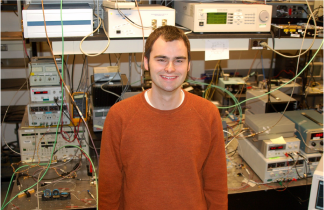 |
| Stomach tissue from my own recent upper GI endoscopy using a conventional commercial endoscope. |
Because my own work in ultrafast laser systems has applications in nonlinear endoscopic imaging, I have used the words “optical biopsy” (the idea that tissue is cleverly analyzed with photons during the procedure instead of "barbarically" exised to be sent to a lab and analyzed later) and “non-invasive” in introductions to papers, talks, or in explanations to lab visitors how an ultrafast laser has relevance to the average person. In the promotion of ultrafast lasers for optical biopsy, I have sometimes talked about how the time and effort it takes to run biopsied tissue through histology is long and arduous-it needs to be sliced thin and stained in order to be viewed with a conventional microscope, and then analyzed by an expert. The patient distressingly waits for a diagnosis and also pays a non-trivial sum of money for the professional time involved for analysis.
I couldn’t have imagined the importance of these motivations before my own endoscopic procedures. What was part of my ultrafast laser stump speech was suddenly very real and worthy. My own experiences were definitely non-invasive. What would have been my options when endoscopes were larger and bulkier? What would have been my options prior to widespread use of endoscopic diagnosis? And though my waiting for histology was short, it was still difficult and definitely costly. What advantages will the next generations have as optical researchers and engineers push endoscopes to use more imaging modalities? Push them to smaller sizes and with more functionality? What peace of mind can we pass on?
No doubt many contributed talks to CLEO 2013 and postdeadline papers will address advances in endoscopic procedures, endoscopes, and catheter-based probes. Last year’s postdeadline session saw two papers on endoscopic imaging: one from a collaboration between John Hopkins Univeristy and Corning, Inc. led by Xingde Li for efficient, high-resolution nonlinear endomicroscopy and the other from Chris Xu’s lab of Cornell University which piggy-backed wide-field one-photon imaging with high-resloution two-photon imaging in the same device for optical zoom capability. There were also a number of contributed submissions regarding advances in endoscopy such as the work by Adela Ben-Yakar’s group of the University of Texas at Austin whose endoscope used the same ultrafast laser for two-photon imaging for targeting tissue and subsurface precision microsurgery through athermal ablation. Last year’s CLEO also hosted an invited talk by Brett Bouma, pioneer of Optical Coherence Tomography (OCT), on translating OCT into GI endoscopy.
This year’s invited speakers in CLEOs Applications and Technology: Biomedical will also be addressing future directions on endoscopes and endoscopic procedures. Invited speaker Jerome Mertz of Boston University will be discussing his work on phase contrast endomicroscopy which was just published in this week’s Nature Methods. His technique cleverly uses two diametrically opposed off-axis sources to allow oblique back-illumination in a reflection mode geometry. Traditionally phase contrast microscopy using oblique illumination requires transillumination and is therefore not suitable for in vivo imaging. Mertz's back-illumination technique allows his microscope to be miniaturized and integrated into an endoscope for which the source and detection optics must reside on the same side of the sample. Unlike traditional oblique illumination phase contrast, Mertz's technique can be used to image thick samples.
Invited speaker Laura Marcu of University of California Davis will be addressing the use of fluorescence lifetime imaging (FLIM) and time-resolved fluorescence spectroscopy (TRFS) in clinical diagnostics. FLIM and TRFS can reveal optical molecular contrast for diagnosis of atherosclerotic cardiovascular disease. However, current approaches using FLIM and TRFS in arterial studies have been primarily ex vivo and in vivo studies have only interrogated exposed plaque. In a recent article in Journal of Biomedical Optics Express, Marcu shows a catheter-based (“endoscopic”) scanning-TRFS system for intravascular interrogation of the arterial wall. Catheter systems are a crucial step for translating TRFS and FLIM into clinical diagnosis.
Finally, invited speaker Andrew M. Rollins of Case Western Reserve University will discuss OCT image guidance for radio frequency ablation (RFA) for treatment of ventricular tachycardia. RFA is a standard treatment for curing many cardiac arrhythmias. However, in cases of ventricular tachycardia (VT), the arrhythmia circuits are located deep in the myocardium or epicardium. Because no technology exists to image cardiac tissue directly during RFA treatment, it has limited success for curing VT. OCT which has the capability of imaging 1-2 mm deep within tissue with micron resolution could be the silver bullet for successful VT RFA procedures. In a recent article in the Journal of Biomedical Optics, Rollins and collaborators from the North Ohio Heart Center, Cardiac Electrophysiology, image freshly excised swine hearts using a microscope integrated bench-top scanner and a forward imaging catheter probe to show the high functionality of OCT for RFA image guidance.
This CLEO I will be looking at imaging research from a different perspective. Whether at the research level or market-ready, advances in endoscopes serve a larger altruistic purpose of potentially giving patients a higher quality life, some control of their health, and dignity. These aren't just empty words to promote optics research but are very real. What a wonderful profession we’re in.


No comments:
Post a Comment